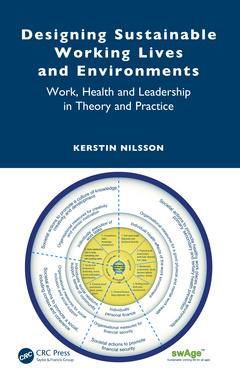Designing Sustainable Working Lives and Environments Work, Health and Leadership in Theory and Practice
Auteur : Nilsson Kerstin

Work is central to people?s lives and the course of their life. The opportunities and chances an individual can have in their life are significantly connected to work. Individuals' work is also crucial for organisations, companies and for the whole of society. There is a constant need to make changes and readjustments of working life since these can deeply affect the individual and their employability. To make working lives more healthy, sustainable and attractive, being aware of the measures and changes that can be achieved in practice is of crucial importance. This book bridges the gap between the theories and explanatory models offered in research and actual work environments and workplaces.
This book constitutes a theoretical framework that visualises the complexity of working life and increases the knowledge and awareness of individuals, companies, organisations and society regarding different factors and patterns. It aims to support individual reflections and joint discussions into daily operations on the individual, organisational and societal level. This book contains practical tools to use in daily working life that analyse possible risks in the work environment when planning measures and actions for health promotion. These practical tools are derived from the four spheres for action and employability in the SwAge model. Developed by the author, the SwAge model (Sustainable Working Life for All Ages) is a theoretical, explanatory model that explains the complexity of creating a healthy and sustainable working life for all ages. By using the SwAge model as a comprehensible framework, the reader will be able to visualise the complexity of factors that affect and influence whether people are able to and want to participate in working life and in the work environment, thereby contributing to increased employability.
Designing Sustainable Working Lives and Environments is an essential read for students, researchers, work environment engineers, ergonomics and human factor specialists, occupational health and safety practitioners, business managers, HR staff, leadership decision-makers and labour union professionals.
Part I Introduction. Determinant Areas for a Sustainable Working Life and Employability. Sphere A. Health effects of the work environment. Area 1. Diagnoses, self-rated health and functional diversity. Area 2: The Physical Work Environment. Area 3. Mental Work Environment. Area 4. Working hours, work pace and time for recuperation. Organisational perspective and action proposals that matter to the health effects of the work environment. Societal perspective and action proposals that matter to health impacts of the work environment. Sphere B. the Financial situation . Area 5. Personal finance and economics. Organisational perspective and action proposals that matter to the financial situation. Societal perspective and action proposals that matter to the financial situation . Sphere C. Social inclusion, support and sense of community. Area 6. The personal social environment. Area 7. The social work environment. Organisational perspective and action proposals that matter to social inclusion, support and sense of community. Societal perspective and action proposals that matter to social inclusion, support and sense of community. Sphere D. The execution of work tasks and activities. Area 8. Work satisfaction, motivation, stimulation and the core of work. Area 9. Knowledge, skills and competence development. Organisational perspective and action proposals that matter to the execution of work tasks and activities. Societal perspective and action proposals that matter to the execution of work tasks and activities.
Part II Age in Relation to a Sustainable Working Life. Biological age in working life. Chronological age in working life. Social age in working life. Cognitive age in working life. All ages in working life.
Part III Practical Application Based on the SwAgeTM Model. Case for Reflection Supported by the SwAgeTM Model. Nine quick ways to increase sustainability in the organisation's environment. The Survey Tool for Investigation and Reflection of Work Ability, Employability and Work Situation. The Tool for Employer/Manager -Employee Work Situation and Career Development Conversations. A Tool for Systematic Workplace Management and an Action plan for a Sustainable Working Life for All Ages. Examples of Measures Taken in Different Workplaces. Tools for Evaluations and Follow-Up of Actions and Measures.
Kerstin Nilsson is Professor in Public Health Epidemiology and Associate Professor in Work Sciences, in the Division of Occupational and Environmental Medicine at Lund University & in Division of Public Health at Kristianstad University, Sweden. Her previous affiliations include the Swedish National Institute of Working Life and Swedish University of Agricultural Sciences, from where she received her PhD in Work Science. She also has a doctorate in Public Health and Epidemiology from Lund University. She is the developer of the SwAge model (Sustainable Working Life for All Ages).
Date de parution : 04-2024
15.6x23.4 cm



